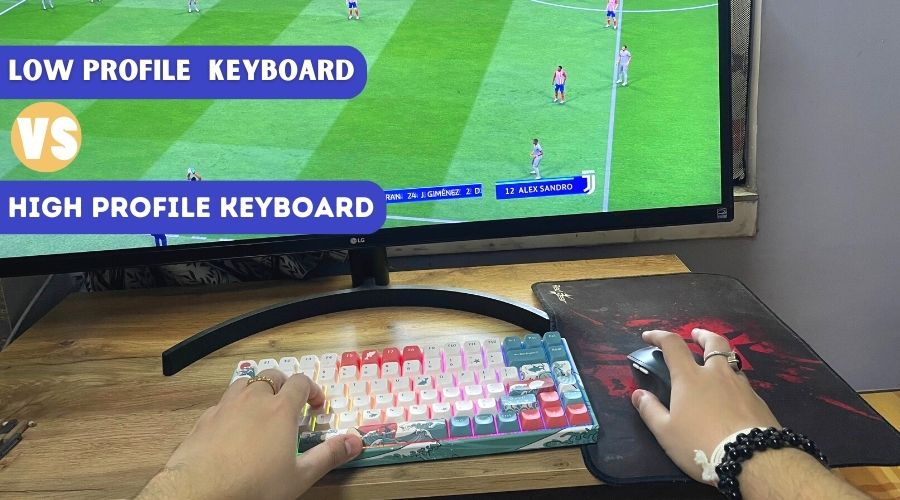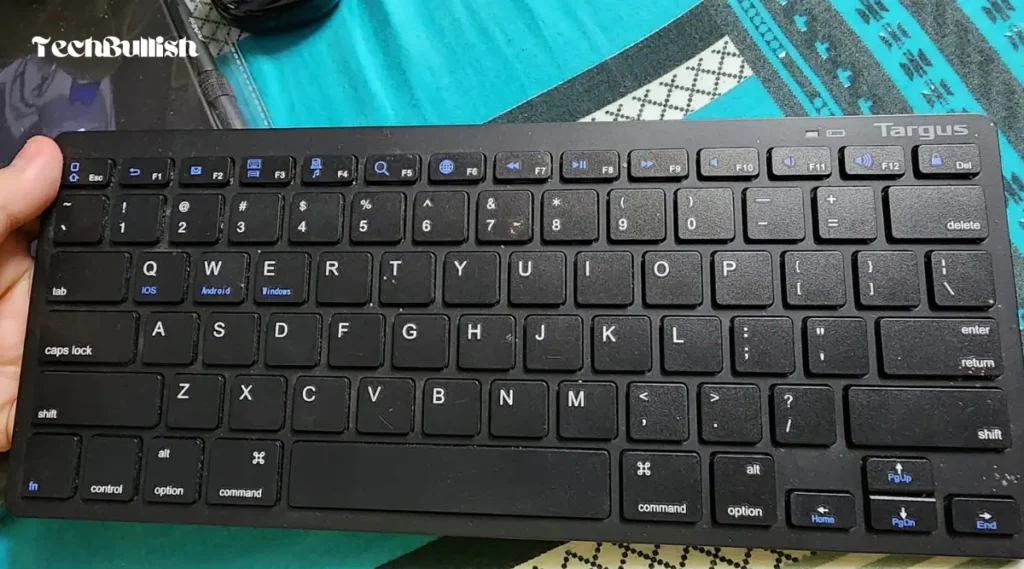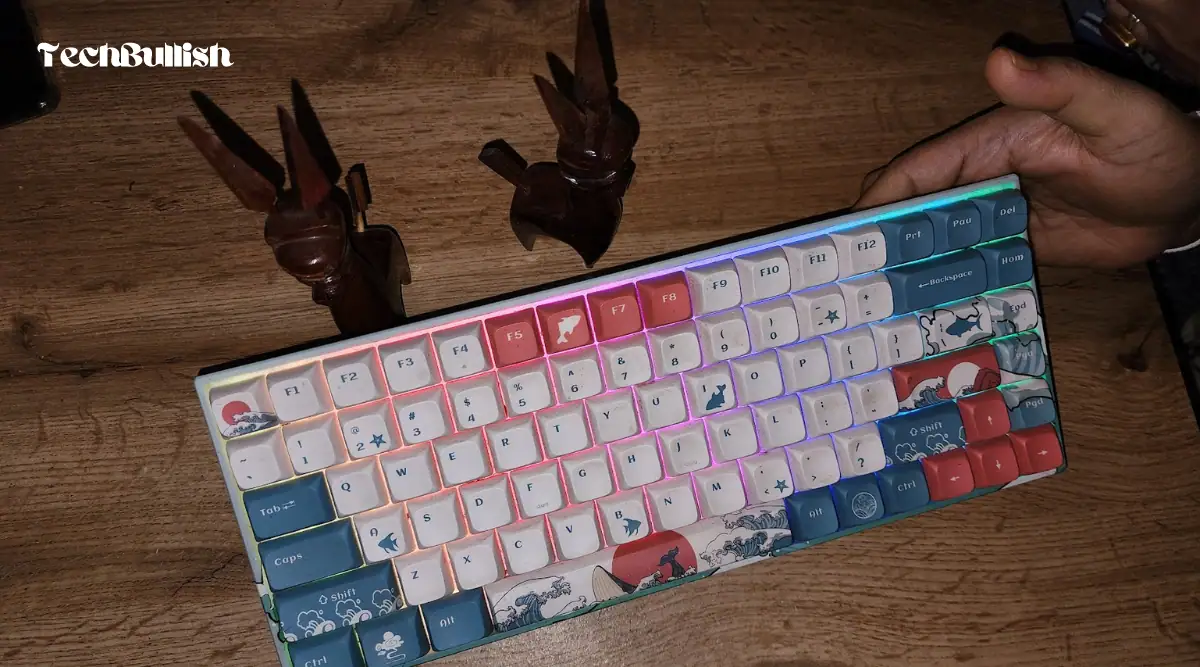When it comes to choosing a keyboard, one of the most important factors to consider is the profile of the keys.
There are two main types of keyboard profiles: low profile and high profile.
The profile of a keyboard refers to the height of the keys, and it can have a significant impact on your typing experience.
Low-profile keyboards are becoming increasingly popular in recent years due to their sleek design and portability.
They are thinner and lighter than high-profile keyboards, making them ideal for travel or for those who prefer a minimalist workspace.
However, low-profile keyboards may not be as comfortable to type on as high-profile keyboards, as the keys are flatter and may not provide as much tactile feedback.

Key Takeaways
- Low-profile keyboards are thinner and lighter, but may not be as comfortable to type on as high-profile keyboards.
- High-profile keyboards offer more tactile feedback and are more comfortable to type on, but may be bulkier and less portable.
Low Profile vs High Profile Keyboard
When it comes to choosing a keyboard, you have two options: low profile and high profile.
Both have their pros and cons and which one you choose depends on your personal preferences and needs.
| Feature | Low Profile Keyboard | High Profile Keyboard |
| Design | Slim, lightweight design with a top piece that sits below the height of the keycaps. | Chubbier and heavier design with a top piece that sits above the height of the keycaps. |
| Switch Options | Often use low-profile mechanical switches, such as Kailh Chocolate switches. | Use a variety of mechanical switches, including high-profile options like Cherry MX. |
| Ergonomics | May require a wrist rest for comfortable typing. | May be more comfortable for those who prefer a higher typing angle. |
| Availability | Becoming more popular, but still less common than high-profile keyboards. | Widely available from major manufacturers like Logitech, Corsair, and Razer. |
Ergonomics
Low-profile keyboards are generally more ergonomic than high-profile keyboards.
They have a shorter travel distance, which means less strain on your fingers and wrists.
They also tend to be more compact, which can help reduce the risk of carpal tunnel syndrome.
High-profile keyboards, on the other hand, have a higher profile and more space between the keys.
This can make them less ergonomic, as you may need to stretch your fingers to reach certain keys.
Portability
Low-profile keyboards are generally more portable than high-profile keyboards.
They are often smaller and lighter, making them easier to carry around with you. They are also more likely to be wireless, which can make them even more portable.
High-profile keyboards, on the other hand, tend to be larger and heavier. This can make them less portable, but they may be more durable and better suited for use in a fixed location.
Typing
Low-profile keyboards are often better suited for typing than high-profile keyboards.
They have a shorter travel distance and actuation point, which can make them faster and more responsive.
They are also more likely to be wireless, which can make them more comfortable for extended typing sessions.
High-profile keyboards, on the other hand, are often better suited for gaming.
They have a longer travel distance and actuation point, which can make them more tactile and satisfying to use for gaming.
Gaming
Low-profile keyboards are not well-suited for gaming.
They often have less tactile feedback and are less satisfying to use for gaming than high-profile keyboards.
High-profile keyboards are often better suited for gaming.
They have a longer travel distance and actuation point, which can make them more tactile and satisfying to use for gaming.
Keycap Profile
Low-profile keyboards often have keycaps with a flatter profile than high-profile keyboards.
This can make them less tactile and less satisfying to type on, but it can also make them more comfortable for extended typing sessions.
Example: The Apple Magic Keyboard is known for its low-profile keycaps, offering a smooth and comfortable typing experience while maintaining a slim and stylish design.
High-profile keyboards often have keycaps with a more pronounced curve, which can make them more tactile and satisfying to type on.
However, this can also make them less comfortable for extended typing sessions.
Example: The Corsair K95 RGB Platinum XT Mechanical Gaming Keyboard features high-profile keycaps, providing a satisfying tactile response for gamers and typists who prefer more feedback while typing or gaming.
Switch Options
Low-profile keyboards typically use low-profile switches, which have a shorter travel distance and actuation point than normal mechanical switches.
This can make them faster and more responsive, but it can also make them less satisfying to type on.
Example: The Logitech G915 TKL Tenkeyless LIGHTSPEED Wireless RGB Mechanical Gaming Keyboard utilizes low-profile GL switches, providing rapid response times and a slim form factor ideal for gamers and professionals.
High-profile keyboards typically use normal mechanical switches, which have a longer travel distance and actuation point.
This can make them more satisfying to type on, but it can also make them slower and less responsive.
Example: The Ducky One 2 Mini Mechanical Keyboard features high-profile mechanical switches from various brands like Cherry MX, Gateron, or Kailh, allowing users to select their preferred switch type.
What Are Low Profile Keyboards?
Low profile keyboards are a type of keyboard that features a sleek and slim design with relatively shorter key travel distance.
They are often thinner and more compact than traditional keyboards.
The keys on these keyboards are closer to the surface and have a flatter profile, which can result in a more comfortable typing experience for some users.
Low profile keyboards are commonly used in laptops, ultrabooks, and some modern desktop keyboards.

Pros:
- Ergonomics: Low-profile keyboards offer better ergonomics with shorter travel distances and actuation points, reducing the risk of carpal tunnel syndrome and providing a more natural wrist position.
- Portability: Compact and lightweight, low-profile keyboards are highly portable, making them ideal for travelers and those working in confined spaces. Some models are wireless, further enhancing their portability.
- Tactile Feel: Low-profile keyboards have a unique tactile feel with smaller switches and shorter travel distances, providing a more responsive and satisfying typing experience. Some low-profile switches even offer clicky feedback.
Cons:
- Switch Design: Low-profile switches have limited availability compared to traditional mechanical switches, potentially impacting their durability and longevity.
- Keycaps: Low-profile keyboards often use non-standard keycaps, making it challenging to find replacements if needed. Some keycaps may also be less comfortable to type on.
- Less Customizability: Due to their smaller form factor, low-profile keyboards offer fewer customization options. Some models may lack removable keycaps, making cleaning and key replacement more difficult.
What are High Profile Keyboards?
High profile keyboards, on the other hand, are the traditional type of keyboards that have been in use for many years.
They have taller keycaps with more space between the keys, resulting in a higher overall height compared to low profile keyboards.
The keys typically have a more noticeable tactile feedback and longer key travel distance, which some users prefer for a more tactile typing experience.
High profile keyboards are commonly found in standard desktop keyboards and mechanical keyboards.

Pros:
- Typing Experience: High-profile keyboards provide a more satisfying typing experience with increased travel distance and tactile feedback, enhancing typing responsiveness and enjoyment.
- Ergonomics: Generally more ergonomic than low-profile keyboards, high-profile models often feature wrist rests and a natural angle, reducing the risk of typing-related injuries.
- Customizability: High-profile keyboards offer more customization options, including various keycaps and switches, allowing users to tailor the keyboard to their preferences.
- Switches: High-profile keyboards often come with durable and responsive switches, such as Cherry MX or Kailh switches, further enhancing the typing and gaming experience.
Cons:
- Portability: High-profile keyboards are less portable due to their larger and heavier design, making them less suitable for frequent travelers.
- Less Ergonomic: While still more ergonomic than low-profile keyboards, high-profile models may not match the ergonomics of specialized options like split or ergonomic keyboards.
- Limited Customizability: Despite offering more customization than low-profile keyboards, high-profile models are still restricted in form factor and switch size, potentially limiting the perfect fit for individual preferences.
- Less Clicky: High-profile keyboards tend to be less clicky than low-profile ones due to a lower actuation point, which may reduce the tactile and responsive typing experience.
Which is Better Between Low Profile and High Profile Keyboards?
When it comes to choosing between low-profile and high-profile keyboards, there is no definitive answer as to which one is better.
It all depends on your personal preferences and requirements.
When making your decision, consider factors such as typing style, gaming requirements, portability needs, and customization preferences.
- Low-profile keyboards: Offer a more comfortable and ergonomic typing experience with shorter key travel. Ideal for people who type extensively and prefer a sleek design.
- High-profile keyboards: Provide a more tactile and satisfying typing experience with deeper key travel. Gamers and touch typists often favor them for precise keystrokes.
Ultimately, the better option depends on individual typing style, gaming preferences, and comfort requirements.
Frequently Asked Questions
Are low profile keyboards better?
Are high profile keyboards better?
Are low profile keyboards better for gaming?
How does the typing experience differ between low profile and high profile keyboards?
Are low profile keyboards more ergonomic than high profile keyboards?

I’m Anirban Saha, Founder & Editor of TechBullish. With a B.Tech in Electronics and Communication Engineering, and 5+ years of experience as a software developer, I have expertise in electronics, software development, gadgets, and computer peripherals. I love sharing my knowledge through informational articles, how-to guides, and troubleshooting tips for Peripherals, Smart TVs, Streaming Solutions, and more here. Check Anirban’s Crunchbase Profile here.
